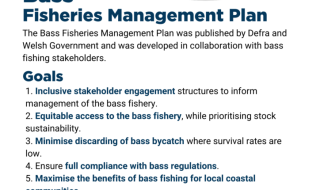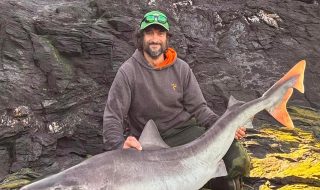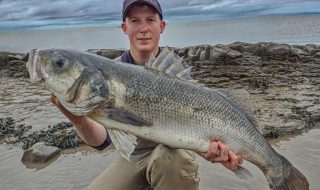Following several successive years of stock decline and a vigorous campaign by recreational angling organisations, the countries of the EU have finally agreed to raise the minimum size at which bass can be harvested by both commercial and recreational fisherman.
The Minimum Conservation Reference Size (MCRS) for bass will increase from 36cm to 42cm across all northern European waters in an effort to protect the stock and allow female bass to spawn.
This completes the package of measures for 2015 aimed at dramatically reducing bass fishing mortality. Other parts of the package included a ban on winter pelagic trawling for bass, a three fish per day bag limit for recreational anglers and most recently monthly vessel limits for commercial bass fisheries.
The increase in MCRS is a move that the Angling Trust and Bass Anglers’ Sportfishing Society (BASS) have battled for more than a decade to get adopted and is a big step towards reducing bass fishing mortality and managing the stock sustainably by allowing at least some female bass the chance to spawn – something female bass can only start to do when they reach around 42cm in length.
No increase in mesh sizes for commercial fisheries have been proposed alongside the increase in MCRS in a bid to reduce the amount of ‘micro-management’ from Brussels – a long standing criticism from the commercial fishing industry.
As a result, commercial fishermen are being expected to change fishing gears voluntarily in order to avoid the time and expense of catching fish below 42cm which, from September 1st when the new MCRS comes in to force, they will be unable to sell. The new measure will apply for the remainder of 2015 after which agreement will need to be reached again on a package of measures for 2016.
In addition to retaining no more than three fish per day recreational anglers will now be required to release all bass caught below 42cm.
David Mitchell, Marine Campaigns Manager for the Angling Trust said: “The recreational angling sector has played a central role in getting the MCRS increased to a level that allows at least some bass the chance to rebuild the stock before being harvested. We are pleased that the package of measures for 2015 has now been agreed and that all sectors will now be playing their part in reducing pressure on the stock. However, the increase won’t come in to force until September and comes with no legal requirement for commercial fishermen to use fishing gears that will avoid catching bass below the new MCRS. Instead they are being expected to move voluntarily to more selective gears that avoid fish below 42cm. Moaning about micro-management from Brussels is no longer an option for the commercial fishing industry and the ball is now firmly in their court to make this works by adapting their fishing gears and fishing practices in order to comply with the new regulation and contribute to reducing their impact on the stock. If not we will be calling on the UK Government to take appropriate measures to ensure that they do.”
Martin Salter, National Campaign Coordinator for the Angling Trust added:”This is clearly good news for our threatened bass stocks and we hope to see some improvement in the dire levels of successful recruitment that recent surveys have revealed. However, there is much more to be done give this fine fish a future and adequate protection from the irresponsible over fishing that has pushed the species to the brink. We need better protection for inshore nursery areas and estuaries where young bass live and we need to move to a fully documented fishery where every bass taken for sale is properly recorded with no exemptions. We may even have to see the introduction of a hook and line fishery only if we are serious about achieving a full stock recovery. The Angling Trust would like to put on record our thanks to the MPs of all parties who worked with us on pressing for meaningful bass conservation measures. Their support has been crucial and we will need them again.”
Ian Misselbrook, Chairman of the Bass Anglers’ Sportfishing Society, said: “Whilst BASS is delighted that movement has been achieved on increasing the minimum size from the current 36cms to 42cms we remain adamant that for there to be long term stock improvement a MCRS of 48cm should be the longer term objective. This, together with additional management measures set out in our Bass Management Plan, might give the stock a fighting chance. I understand that the Commercial fishing sector have been equally concerned about the state of the stock and therefore the Commission has given them the burden of responsibility to ensure the necessary gear changes will be introduced to improve selectivity and avoid bass below 42cm which they will no longer be able to sell. The Commercial fishing industry must now take responsibility for making sure this happens. I am hoping that after many years of BASS, the Angling Trust and European Anglers Alliance lobbying this is now the start of the introduction of progressive long term management measures that will give us all more and bigger bass.”
Jan Kappel, Secretary General of the European Anglers Alliance (EAA) said: “We warmly welcome the adoption of the new 42cm MCRS but the EU Member States have to learn to operate more effectively as it has taken nearly three years for them to reach agreement on this package of measures. Now that bass is being managed by the EU we can expect better data collection on the stock as well as bass to fall under the landings obligation (discard ban) from 2019. It is a shame that the new MCRS only applies to northern EU waters. We will continue to lobby for it to be introduced in the southern waters too.”The Commission was forced to make proposals to manage bass at EU level after it became clear that individual Member States were failing to manage the stock sustainably. Management at EU level – ultimately leading to inclusion in a long term management plan – means better data collection on bass over coming years which is essential for management measures to be effective.
Scientific advice on fishing for bass in 2016 published by the International Council for the Exploration of the Seas (ICES) recommends yet another drastic reduction in fishing catches from 1115 tonnes in 2015 to no more than 541 tonnes in 2016.The package of measures agreed by the EU in 2015 has been hard and fast by EU standards but much more stringent measures are going to be needed in 2016 if catches are going to be reduced anywhere near the level advised by ICES. If not a total closure of bass fishing in northern Europe could be the only option left to avert a total stock collapse. The Angling Trust and BASS are continuing to press the UK government to take further action to protect bass in UK territorial waters – an approach that has been successfully adopted by the Irish government which now has a recreational fishery generating up to 20 million euros in economic benefit.






